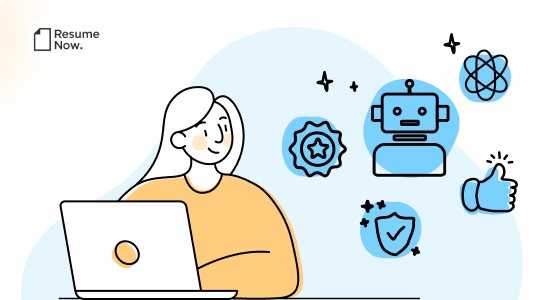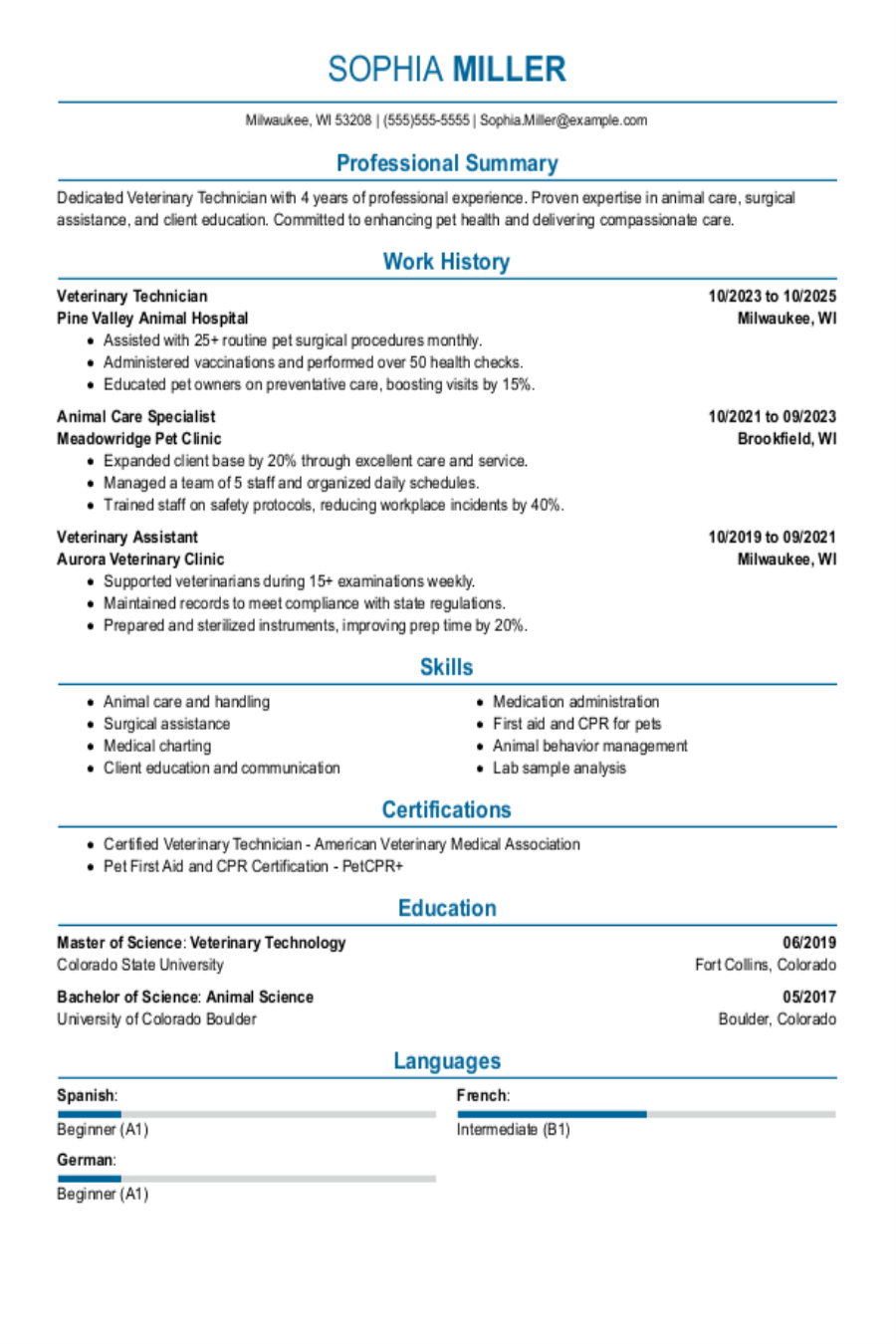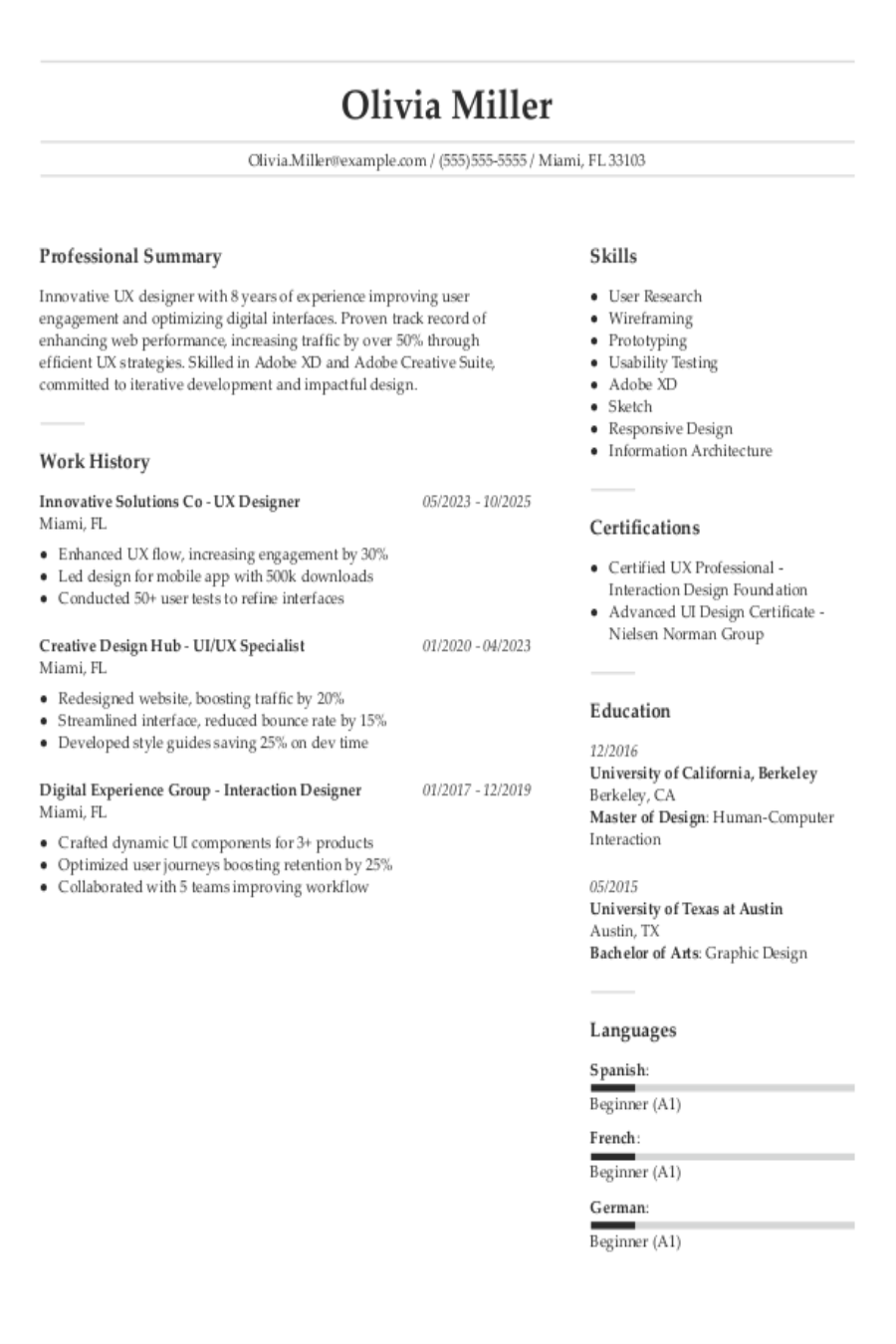To land the job you’ve been dreaming of, you need a current resume that impresses employers and shows that you have the passion, knowledge, and experience they’re looking for. Our guide will help you update your resume to display your skills and communicate your relevant expertise and career growth.
In this guide, we’ll answer your questions like:
- When do I need to update my resume?
- Why do I need to update my resume?
- How do I update my resume to show my growth as a professional?
Want an application-ready resume in minutes? Try our AI Resume Builder. This tool includes neat resume templates and AI-powered resume content that’s unique and customized to help you impress recruiters.
When To Update Your Resume
Before you start the process of updating your resume, you might be asking yourself: “Do I need to update my resume?” The answer depends, but in most cases, giving your resume a second look and a quick refresh is helpful to keep your information fresh and polished.
So, when should you update your resume? There are a few situations that should inspire you to give your resume a makeover:
- You’re starting a job search: The most obvious reason to update your resume is that you’re beginning to search for a job. If your current role isn’t on your resume, you’ll need to add it and discuss the ways that your career and skills have evolved since your last job hunt.
- You’re customizing your resume for a specific role: Resume experts recommend customizing your resume for each role you apply for to ensure that your resume’s content is fresh and aligns with the qualifications that the hiring department is seeking. This will usually be a minor update where you add new keywords that will help make your resume more ATS-friendly. Depending on the expectations of the role, you may also choose to highlight different areas from your experience or adjust the skills that your resume focuses on. If you’re concerned about your resume’s ATS performance, try using an ATS resume checker to gain some insight.
- You’ve been upskilling: Learning new skills, earning new certifications for your resume, and improving your professional prospects is a huge step forward that you should feature proudly on your resume. Even if you aren’t currently job-hunting, it’s a good idea to have an up-to-date resume handy that shows your career journey and growth.
- You’re seeking a promotion: Maybe you aren’t exactly job hunting, but your current organization has an opening that seems perfect for you. A resume for an internal promotion needs to be up to date to showcase your achievements at your current role.
Why Should You Update Your Resume
Updating your resume is an important career move, even when you’re not actually on the hunt for a new role. You never know when an opportunity will come your way, and it pays to be prepared.
Here are some key reasons why you should update your resume:
- To be ready for new opportunities: When your resume is up to date, you can embrace new opportunities that come your way without first having to stop and check “update resume” off your to-do list. Having an updated resume gives you the agility to respond to unexpected pathways.
- To be mindful of your career goals: When you’ve been in a comfortable role for a while, it can be easy to get into a routine. This is a good thing, but it’s also important that you don’t lose sight of your career progression. Remembering where you’ve come from and keeping sight of where you want to go is a key habit that will help you achieve your goals. An updated resume can help you track your progress and visualize your value as an employee.
- To stay current: Your resume is a vital tool in your career toolbelt. If you’ve racked up some impressive new accomplishments since its last update, then now is a good time to add them. Additionally, if your resume is older, an update is a great chance to give it a makeover and bring your achievements to life with a modern style that matches your personal brand.
How To Update Your Resume
Now that you know when and why you should refresh your resume, it’s time to dive into how to update a resume. Depending on how recent your resume is, the career changes you’ve made since its last update, how happy you are with its style and content, and the specific purpose of this update, you might make smaller or bigger changes to your resume.
Even if you’re only planning on giving your resume a light refresh, our step-by-step guide will help you rest easy knowing that you’ve crossed all your T’s and dotted all your I’s.
Identify sections that are out of date
Start your resume update by reading your old resume carefully. Does it reflect who you are as a professional right now? Is there anything big missing, like your current role or a recently completed degree?
Go over each section to make sure that the information that’s there reflects your current career stage and furthers your career goals. Make a list of anything that might be missing so you can add it in later and take note of any big changes you may want to make.
Double-check your contact information
It might not be the most challenging or creative section, but the contact information in the header of your resume is arguably the most important. Without it, how would a potential employer reach out?
Start your resume update by reviewing this section. If you’ve moved addresses or received a new phone number, make those changes immediately. Otherwise, just run through the header and double-check that everything is both accurate and up to date.
Pro tip: The email address on your resume should be professional. If your usual email address is silly or overly casual, then it’s probably time to replace it with a professional-sounding address that uses your name or initials. Something like “johndoe@example.com” or “abjohnson@example.com” works perfectly.
Study the job description
Most of the time, when you update your resume, it’s because you have an opportunity in mind. This isn’t always true, but if this is you, then you should pay close attention to the job description of the role.
You should pay attention to keywords that the job description uses to describe the ideal candidate and use your resume update as an opportunity to include those keywords and show off how well your skills and experience align with the role.
Rewrite your resume profile
Whether you go with a professional summary or you focus on your aspirations in a resume objective, your resume profile should quickly summarize your career at the top of your resume.
This is the first section that digs into who you are as a professional, so make sure it’s fresh and includes your current career status. If you’ve gained significant experience since your last resume update, it would be wise to rewrite this section altogether.
Take advantage of our AI Resume Summary Generator to give you more options when updating your profile. Even if you want to turn it into an objective statement, our generator can help by providing customizable content that focuses on your best qualifications.
Pro tip: Keep your resume profile short and snappy. If you have a lot to add to it, then try rewriting to eliminate old information and make room for newer and more relevant points.
Add new skills
No matter your career, modern professionals are always picking up new skills. Think about the hard skills that your new experiences have earned you, as well as the soft skills that you’ve honed as your career has contributed to your personal growth.
If you’re not sure which new skills to add to your resume, pay attention to the skills listed in the job description for inspiration.
Want some new skills to refresh your resume? Try our free AI Resume Skills Generator. This tool will generate a list of relevant skills based on your job title in just seconds. Take your favorite skills and add them to your resume to make your skills section shine!
Remove old or irrelevant experience
A few years ago, when you had less overall experience, it might have made sense to include your part-time babysitting gig or your first retail job on your resume to prove that you had experience in the workforce. Now that you’ve had some time to grow, these older roles might not be a good use of your limited resume real estate.
Update your resume’s work history section by adding your new experiences and removing the older ones that are irrelevant to your current career stage or to the role you’re pursuing. You don’t have to remove all of your older roles, but when space is limited, you may need to remove a few bullet points or completely get rid of any irrelevant work experience that isn’t a good match for your current goals. Those earlier roles are still a part of your journey, though, so feel free to include any relevant skills that they taught you in your skills section.
Invigorate your language
Part of the fun of updating your resume is infusing old, stale content with new life and energy. One way to do this is to look for passive phrases on your resume and replace them with action-packed verbs that convey your confidence.
Instead of saying “responsible for answering customer inquiries,” say “bolstered customer satisfaction by 33% through empathetic communication.” Including numerical figures—so long as they’re accurate figures—can add a sense of legitimacy and impact to your achievements.
Add new certifications and update your education
Your experience at work has taught you lots of new things since your last resume update, and that’s fantastic. But if you’ve been actively upskilling and pursuing new career skills and milestones inside or outside of the workplace, that’s even better!
Have you completed a leadership course? Earned a new degree or certification? Undergone on-the-job training in a new area of specialization? Include these achievements in your updated resume. List new degrees in the education section of your resume, while certifications can go under education or in their own section, depending on how you organize your resume.
Pro tip: If you’re looking for ways to step up your job search, certifications are the perfect way to learn new skills and demonstrate expertise. Certifications on your resume show that you’re dedicated to continuous learning and improvement.
Give your resume a makeover
Now that your resume’s content sounds fresh, it’s time to make it look and feel fresh. Do this by trying out a stylish new resume template that captures your personal brand.
Your resume’s style should never distract from your accomplishments, but a pop of color is an eye-catching way to stand out from the crowd of applicants that most recruiters sift through. Just use your best judgment and consider your role before settling on a new template.
A paralegal for a prestigious law firm should use a traditional, simple template that focuses on professionalism. At the same time, an aspiring music teacher can afford to get more expressive with a creative template that radiates personality.
Update social media
These days, networking is a huge part of securing an exciting role. Now that your resume is up to date, it’s time to give your LinkedIn profile some attention. Add your recent experience to your profile and consider if any of the changes you made to your resume might apply to your profile.
Update your resume on LinkedIn to match your new and improved resume, and be sure to revisit your LinkedIn skills. Emphasize skills that match your current career focus and present opportunities for colleagues to endorse your abilities.
Maybe it’s time for a new professional headshot to give your page some new life and show potential employers that you’re open to new opportunities!
Key Takeaways
Add new experience
Your resume can’t be up to date unless your latest experience and newest career skills are featured.
Update your information
Make sure your contact information is accurate to ensure that potential opportunities can reach you.
Energize your language
Give your resume extra pep by refreshing your word choice to keep things short, sweet, and action-packed. Look for passive phrases and replace them with energetic action words.
Customize your resume
The best resume is one that’s tailored to each job application. Matching your resume to the role will help you stand out as the ideal candidate and allow you to make sure each section of your resume is working hard to land you the role you’re after.
Refresh your resume style
Add new life to a stale old resume by choosing a new resume template with more personality, polish, or modern style than before. Don’t be afraid of adding a pop of color, so long as you don’t overdo it.
Was this information about How To Update Your Resume For Success In 2025 helpful? Let us know!
Hailey is a career advice writer dedicated to helping job seekers excel in their careers.
More resources

How to Include Networking Skills on a Resume (40+ Examples, Definition & Tips to Improve)
What are networking skills? We ll answer this and all your p...

RoboBossing: 66% of Workers Say AI in Leadership Would Make the Workplace More Fair and Efficient
Resume Now s latest report finds growing support for thoughtfu...

How to Write a Resume for a Career Change
Need a resume to showcase your unique career path? Our guide c...

Virtual Assistant Resume: Examples, Templates and Tips
Build & download your Virtual Assistant resume in a few simple...

Vet Tech Resume: Examples, Templates & Tips
Get inspired with our vet tech professional resume examples as...

UX Designer Resume: Examples, Templates and Tips
Check out our resume examples for help getting your UX designe...
